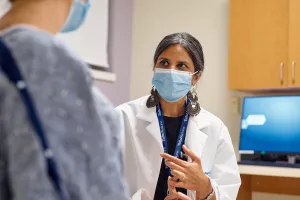A mammogram is a low-dose X-ray that helps find breast tumors early, often before they can be felt. It’s the gold standard for detecting and diagnosing breast cancer. If you’re a woman or an individual assigned female at birth (AFAB) over age 40, getting a mammogram every year is a simple way to stay one step ahead of breast cancer.
A clear picture of your breast health
Mammograms save lives. They help us find breast cancer early—before it grows or spreads. That’s why we encourage everyone to take charge of their health and stay on track with routine mammograms.
Whether it’s time for your yearly screening or you want to check new breast changes, our team is here to help. We use the latest technology to detect and diagnose breast cancer as early as possible. The American Cancer Society says that when breast cancer is found early (before it spreads), the survival rate is 99%.
At Tufts Medicine, we use advanced 3D mammography (tomosynthesis) to see breast tissue in greater detail than traditional 2D mammograms. It’s one more way we’re helping you keep your breast health a part of your best health.

Conditions
About 1 in 8 women and individuals assigned female at birth (AFAB) will be diagnosed with breast cancer during their lifetime. It most often starts in the milk ducts or the glands that make milk.
While breast cancer is the most common cancer among women and AFABs, it can affect anyone. That’s why regular breast cancer screening is so important.
When should you start getting mammograms?
Tufts Medicine and t he American Cancer Society recommend starting yearly mammograms at age 40. Around this age, the risk of breast cancer rises—the rate is up to three times higher for people in their 40s than in their 30s.
Personal and family medical history can also affect how often someone should get a mammogram, so it’s important to talk with a doctor about what’s right for you.
Testing
Mammograms play two important roles in breast health. Depending on a person’s health history, a doctor may recommend one or both types:
- Screening mammogram: For people without symptoms or known breast issues. Part of preventive breast care.
- Diagnostic mammogram: For people with breast symptoms or as a follow-up to a screening mammogram that found something unusual.
Routine screening mammograms involve several images of each breast. Sometimes additional images are needed from a slightly different angle to clarify questions. Many people are cleared by a diagnostic mammogram and don’t need further testing until their next screening.
Radiologists review results and report findings within one week to a primary care doctor, gynecologist, oncologist, or other members of the care team.
All Tufts Medicine mammography facilities are licensed by the Massachusetts Department of Public Health and accredited by the American College of Radiology, ensuring high-quality, safe care.
3D mammogram: Advanced breast imaging
3D mammography, or tomosynthesis, can detect lumps hidden by overlapping breast tissue. It starts by taking 2D images, which are then layered to create a 3D view. This allows radiologists to examine breast tissue one layer at a time, showing more detail than traditional 2D mammograms.
What happens if a 3D mammogram finds something abnormal?
Mammograms are often the first step in spotting suspicious changes. Because they cannot confirm breast cancer on their own, follow-up tests may be needed:
- Breast ultrasound: Takes about 20 minutes. A sonographer uses sound waves to create images for radiologists.
- Diagnostic mammogram: Focuses on a specific area by compressing the breast tissue differently. Also called a “spot” or “compression” view.
Understanding breast density
Breast density is a key factor in breast health and screening. It describes how much fibrous and glandular tissue is in the breast compared to fat, and higher density can make it harder to detect changes on a mammogram. Knowing your breast density helps doctors recommend the right screening plan and keeps you proactive about your breast health.
Advanced technology allows radiologists to grade breast density. With an annual 3D mammogram, patients receive their latest breast density grade.
Breast density measures how much fibrous and glandular tissue (fibroglandular tissue) is in the breast compared to fat tissue.
The 5 main components of the breast are:
- Lobules: Glands that produce milk
- Ducts: Tubes that carry milk from lobules to the nipple
- Glandular tissue: Includes lobules and ducts
- Fibrous tissue: Connective tissue that supports the breast and, along with fat, gives shape
- Fat tissue: Fills space between glandular and fibrous tissue
Breast density grades:
- A: Mostly fatty tissue
- B: Scattered dense fibroglandular tissue
- C: Large areas of fibroglandular tissue (heterogeneously dense), which can make spotting changes harder
- D: Extremely dense fibroglandular tissue, making detection of changes more difficult
Understanding your breast density helps guide the right screening plan. Dense breasts (grades C and D) have more fibrous and glandular tissue, which can make it harder to detect lumps on a mammogram. Nearly half of women and AFABs fall into these categories.
Knowing your breast density allows doctors to recommend additional or earlier screening if needed, helping you stay proactive with breast health. Even if your breasts are less dense (grades A or B), it’s still important to keep up with regular mammograms.
Your radiologist will review your breast density and explain what it means for your screening schedule so you can make informed choices about your health.
FAQs
Mammograms help find breast cancer early when it’s easiest to treat. Regular screening can lower your risk of dying from breast cancer and has helped reduce death rates over the last 30 years.
The American Cancer Society recommends starting yearly mammograms at age 40. If breast cancer runs in your family or you have a BRCA1 or BRCA2 gene, your doctor may suggest starting earlier. Talk to your doctor about a screening plan that’s right for you.
A mammogram is a low-dose X-ray of your breasts that checks for signs of cancer. It’s quick, safe, and highly effective at finding changes before you notice symptoms.
There are two types:
- Screening mammogram: For people without symptoms or known breast issues
- Diagnostic mammogram: For people with breast symptoms or after a screening finds something unusual
A 3D mammogram, also called tomosynthesis, takes multiple images to create a layered view of breast tissue. This helps radiologists spot lumps hidden by dense tissue and can reduce false positives. Most Tufts Medicine locations offer 3D mammograms as the standard for breast screening.
You’ll remove your top and wear a gown. Each breast is gently compressed between two plates while images are taken. The pressure lasts only a few seconds. The whole visit takes about 30 minutes.
You might feel brief pressure, but most people describe it as uncomfortable, not painful. If you’re nervous, let your technologist know—they can help make the process easier.
Don’t wear deodorant, lotion or powder under your arms or on your breasts. These products can show up on the images. If you forget, wipes are available at most facilities.
Wear a two-piece outfit so you only need to remove your top. Bring a list of any breast procedures you’ve had. Try to schedule your mammogram when your breasts aren’t tender, usually a week after your period.
Yes. Technologists are trained to take special images around implants to ensure clear results. Be sure to mention your implants when scheduling.
Yes, but your doctor may suggest another test like an ultrasound. Talk to your doctor about what’s safest and most effective for you.
Breast density describes how much fibrous or glandular tissue you have compared to fat. Dense tissue can make it harder to spot small tumors on a mammogram. About half of all women have dense breasts.
You can’t feel breast density. It only shows up on a mammogram. Your radiologist will review your images and let you know if your breasts are dense. In Massachusetts, you’ll also get a written notice after your mammogram.
Your doctor might recommend regular 3D mammograms, breast ultrasounds, or MRIs for a closer look. Having dense breasts doesn’t mean you’ll get breast cancer, but it can make early detection harder. Talk to your doctor about the best plan for you.
Most follow-up tests confirm normal breast tissue. Your doctor may recommend a breast ultrasound or another diagnostic test to learn more. You’ll get clear next steps and support every step of the way.
Screening mammograms are covered by most insurance plans for people over 40. In Massachusetts, free or low-cost mammograms may be available through the Massachusetts Breast and Cervical Cancer Program.
Tufts Medicine offers mammography at multiple hospitals and imaging centers. You can schedule online through myTuftsMed or call your nearest location.
Take deep breaths, listen to music, or bring a friend for support. Ask questions if anything feels unclear. The staff is there to help you feel comfortable.
Ask about:
- When to start screening
- How often to get mammograms
- What your breast density means
- If additional imaging could help you
Talking with your doctor helps create a plan that fits your unique health needs.

From regular office visits to inpatient stays, find the healthcare you need and deserve close to home.